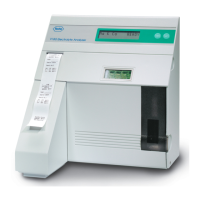Roche Diagnostics
146 Instructions for Use · Version 10.0
9 Maintenance 9180 Electrolyte Analyzer
Unscheduled maintenance
When the analyzer detects that the SnapPak has been removed, the display
prompts STATUS: NO SnapPak. In addition, the printer will print out the
current status of the SnapPak.
q
If your 9180 Electrolyte Analyzer has a serial number greater than 21000, visually
inspect the connector pins for moisture, dirt and damage on its surface after each
SnapPak exchange. Press the connector pins gently towards the inside of the analyzer
and check that they return to their original position.
When inspecting or cleaning the connector pins, take care not to use excessive force
that would bend the connector pins.
If there is moisture on the connector pins, clean them wipe them with a cotton swab or
a clean, dry or moist cloth. Do not use Deproteinizer or other disinfectants to clean the
connector pins.
If there is dirt on the connector pins, remove the dirt using a fiberglass or synthetic
brush, such as a toothbrush.
If the connector pins are bent or broken, or the spring of the connector pins does not
work after applying gentle force, contact your Roche Service representative.
o Prepare the new SnapPak by carefully removing the protective strip. Save this
protective strip to close the connectors before disposing the used SnapPak.
o Write the installation date on the label of the new SnapPak.
q
After the protective strip has been removed from the SnapPak, keep the SnapPak
upright to avoid spillage.
o Slide the new SnapPak into position on the left side of the analyzer.
o The analyzer will prompt New SnapPak Installed?.
Figure 9-14
o Press YES to indicate that a new SnapPak is installed. At the prompt Are you
sure?, press YES. The 9180 Electrolyte Analyzer will automatically reset the
SnapPak counter to 100% and commence system calibration.
o Press NO if you reinstall the SnapPak that was removed.
o After checking the reagent fluid level and changing the SnapPak, QC
measurements on 3 levels have to be performed to verify the performance of the
instrument.

